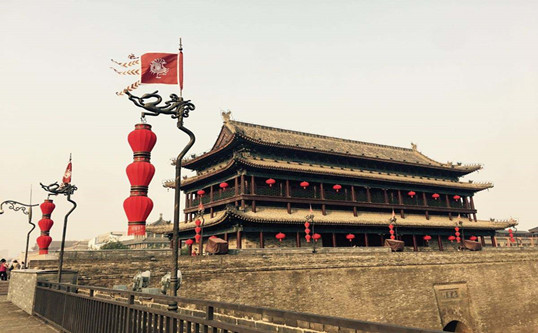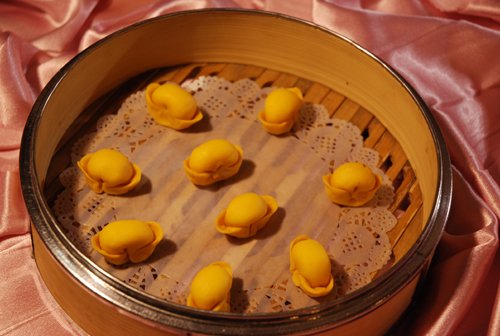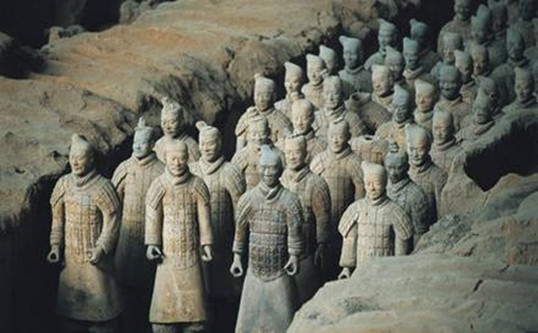
It was the Tang Empire that set its capital at the present site of Xi’an, with a perimeter of 35 kilometers long city wall.
The City Wall of Xi’an is just at the center of Xi’an municipality, in a rectangular shape and with the length from east to west a little longer than that from south to north. The perimeter of the city wall is 11.9 kilometers, with four gates constructed in the four directions of east, south, west and north. The construction system of the city gates is in a four-rampart and 12-gate style. The Northern City Gate is called Anyuan Gate, the Southern City Gate is called Yong’an Gate, the West City Gate is called Anding Gate, and the East City Gate is called Changle Gate. It was rebuilt and extended on the base of the original Tang Dynasty Palace Wall from the seventh year to the eleventh year of Hongwu in Ming Dynasty (from 1374 to 1378 AD). It has a history of 600 years up to now and it is also the most large, solid and complete city wall which has survived through the long history in China.
Xi’an is called Chang’an in Chinese history. Chang’an, as an ancient organizational capital city, has a history of over 3,000 (called Haojing in Zhou Dynasty, Xianyang in Qin Dynasty and Chang’an after Han Dynasty up to the time before the Ming Dynasty). It was the Tang Empire that set its capital at the present site of Xi’an, with a perimeter of 35 kilometers long city wall. Such a large-scale city wall construction is rarely found in the world history. Therefore, it is regarded as one of the four ancient capital cities together with the Italian city "Rome", "Athens" of Greece and "Cairo" of Egypt. The Tang City Wall was ruined in a war at the beginning of the 10th century AD. At the end of Tang Dynasty, in the first year of Tian You Period (904 AD), the city governor Hanjian of the security army which settled in Chang’an rebuilt the city wall on the base of the inner city wall of the Tang Dynasty Imperial Palace of the Tang Chang’an city. This is the original shape of the present city wall. In the second year of Hong Wu in the Ming Dynasty, the founder of Ming Dynasty Zhu Yuanzhang occupied "Fengyuanlu" (the new city rebuilt by Hanjian) and changde the name of "Fengyuanlu" into "Chang’an Fu", hence the name "Chang’an" has been used ever since. Meanwhile, he nominated his second son Zhushuang as "King Qin" to govern this area, and ordered an inner city "King Qin’s Palace" ("New city" where the Shaanxi Provincial government is now located) built inside the city of Xi’an. In the seventh year of Hongwu Period (1370 AD), Zhushuang started to widen and make higher the city wall rebuilt by Hanjian, and extended the northern city wall and the eastern city wall outwards in a degree of one-third, thus formed the present scale of the city wall.
The city wall of Xi’an is 12 meters high, 15 meters wide on the top and 18 meters at the bottom, with battlements of 1.65 meters high. Laid on the top are three layers of bricks, which make it convenient for drainage. In the four directions, there is a city gate tower and arrow tower each. Each city gate tower has 3 ramparts and 3 entrances, which make up 4 inner cities (or compounds). In front of each inner city (or compounds), there is a Zhalou (rampart with a suspense bridge. The three ramparts standing in a line, with upturned eaves up into the sky, make up a magnificent scene. The surrounding moat just outside the city wall makes it imregnable.





| NAME |
| EMAL |
| MESSAGE which includes pax & tour dates |
| Success China Tours North America Department Beijing Golden Peak International Travel Service Co., Ltd | |
| Telephone:86 10 83065275 | |
| Email:info@successchinatours.com | |
| Address:Room214, Zone A, No.4-6 BaiguangRoad, Xicheng District, Beijing |

Professional Travel Service for All Your China Travel Needs
Copyright © 2001 - 2018, Success China Tours